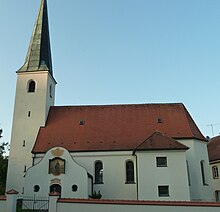Grünbach (Polling)
|
Grünbach
Polling municipality
Coordinates: 48 ° 12 ′ 17 ″ N , 12 ° 32 ′ 21 ″ E
|
|
|---|---|
| Height : | 413 m above sea level NHN |
| Residents : | 100 (2012) |
| Incorporation : | July 1, 1970 |
| Postal code : | 84570 |
| Area code : | 08630 |
Grünbach is a district of the municipality of Polling in the Upper Bavarian district of Mühldorf am Inn .
location
The church village is located about 2 km southwest of Polling , a good 2 km southeast of Flossing and about 3 km north of Oberneukirchen on the eponymous Grünbach in the idyllic landscape of the Grünbach valley, which is part of the Natura 2000 area "Grünbach and Bucher Moor".
history
The year Grünbach was first settled is unknown. In any case, around 1260 the Spanheimers zu Kraiburg had a farm each in Anzenberg, Grünbach and Reichthalham. The Catholic branch church St. Leonhard of the parish Flossing is a single-nave hall building with a west tower, choir with wall pillars. It is essentially late Gothic (15th century) with Baroque modifications in 1737 and by Franz Alois Mayr in 1759. The village has belonged to the Duchy of Bavaria since the Middle Ages , but the neighboring town of Mühldorf am Inn until 1803 to the Archbishopric of Salzburg . Until 1966 Grünbach belonged to the school district Flossing, since then to the school district Polling . From the Bavarian municipal edict of 1818 until the municipal reform , Grünbach was an independent municipality with the following districts:
|
|
|
|
On July 1, 1970, it was incorporated into Polling (Mühldorf a. Inn district) .
Web links
Individual evidence
- ↑ Müller's Large German Local Book 2012 . De Gruyter Verlag, 2012, p. 485.
- ↑ NATURA 2000 area research online. Retrieved May 6, 2020 .
- ↑ List of monuments for polling (PDF) at the Bavarian State Office for Monument Preservation
- ^ Wilhelm Volkert (ed.): Handbook of Bavarian offices, communities and courts 1799–1980 . CH Beck, Munich 1983, ISBN 3-406-09669-7 , p. 525 .
